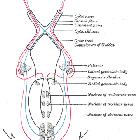sphenoethmoidal air cells










Sphenoethmoidal air cell, also commonly known as the Onodi air cell, is an anatomical variant of the paranasal sinuses, important due to its close proximity to the optic nerve and internal carotid artery.
Terminology
The sphenoethmoidal air cell is generally defined as the posteriormost ethmoidal air cell, that extends posteriorly to lie superolateral to the sphenoid sinus and thus in close proximity to the optic nerve and internal carotid artery . It often extends into the anterior clinoid process; importantly, aeration of the anterior clinoid process does not imply presence of an Onodi cell, as frequently such aeration is due to rescesses of the sphenoid sinus .
Rarely, it may lie superiorly to the sphenoid sinus and is then called a central Onodi air cell .
Epidemiology
The incidence of sphenoethmoidal air cells is variable, reported in 3.4 to 60% of individuals ; the discrepancy of these rates of incidence likely results from variability in definition rather than true incidence .
Clinical presentation
Onodi air cells are usually asymptomatic, unless complicated by sinus disease (e.g. mucocoeles, squamous cell carcinoma, and acute sinusitis, which have all been reported in sphenoethmoidal air cells), leading to early optic nerve involvement.
The importance of these air cells stems primarily from their location adjacent to the optic nerve and internal carotid artery, with as little as 0.03 mm (median 0.08 mm) of bone separating them .
Potential damage to these critical structures occurs when attempts to enter the sphenoid sinus endoscopically are made by passing through the posterior wall of the sphenoethmoidal air cell expecting to enter the sphenoid sinus .
History and etymology
The importance and variability of the posteriormost ethmoidal air cells was described by the Hungarian laryngologist Adolf Ónodi (1857-1920) in 1904 .
See also
- transsphenoidal hypophysectomy
- functional endoscopic sinus surgery
- concha bullosa: aerated middle turbinate
- agger nasi cells: anteriormost ethmoidal cells
- Haller cells: infraorbital ethmoidal air cells
- pneumatized dorsum sellae
Siehe auch:
- Arteria carotis interna
- Sinusitis sphenoidalis
- Sinusitis
- Concha bullosa
- Hallersche Zelle
- Nervus opticus
- Mucocele
- Agger nasi Zelle
- pneumatisiertes Dorsum sellae
und weiter:

 Assoziationen und Differentialdiagnosen zu Onodizelle:
Assoziationen und Differentialdiagnosen zu Onodizelle:








